|
|
Sega AISega Master System / Mark III / Game Gear |
Home - Forums - Games - Scans - Maps - Cheats - Credits |
Sega AI Computer (セガAIコンピューター)
Updates
- 2024-01-31: Initial publication. Minor tweaks made.
- 2024-02-01: MAME patch #11991 will fix an issue where incorrect voice samples are being played (from next release).
- 2024-02-13: Gentle request, if you write articles or make videos about this, try to credits multiple people involved rather than one person :)
- 2024-03-05: Discovered two new titles and purchased them.. stay tuned..
Introduction
Around late 1986, Sega released the “Sega AI Computer”. This is one of Sega’s least well known and rarest systems. Not much is known about this system apart from a small amount of information in Japanese and American flyers and press articles. The information we have is still piecemeal and may be partly inaccurate.
Today we are making public, for the first time: all system roms extracted from the Sega AI Computer, data dumps from 26 my-cards and 14 tapes, many scans and photographs, and in collaboration with MAME developers, an early working MAME driver allowing this computer to be emulated.
The majority of these software titles had zero information about them on the internet prior to us publishing them: no screenshots, no photos or scans of actual software. Considering the elusive nature of this machine, it is possible that some games have never been seen or completed by anyone outside of their original development teams.
We hope that this release will be interesting to obscure game and computer historians and hobbyists alike. We will further amend it over time by releasing extra scans, hopefully improving emulation and publishing/discovering new information.

Extract from a US ad (1986)
System Specs
- Year: 1986
- CPU: 16-bit NEC V20 at 5 Mhz
- ROM: 512 KB total (as actually found in system)
- 2x64 KB system ROM (“Operating System, Prolog”)
- 1x128 KB character ROM
- 2x128 KB speech ROM
- RAM: 128 KB
- Software on Sega My Cards (128 KB to 256 KB).
- Software on Audio Cassettes.
- Video : Yamaha V9938 (Resolution 256x212) with 64 KB VRAM.
- Sound: SN76489 PSG
- Inputs: Touch surface with overlays, 8-directions pad + 3 buttons.
- Inputs: Microphone input.
- Inputs/Outputs: a RS232 Centronics port
- Cassette Drive : 9600bps.
- Optional Keyboard peripheral.
- Optional Sound Box peripheral with a YM2151 FM chip.
An early flyer suggest the possible planning or existence of: a BASIC programming ROM Card, a Disk Drive extension, a Bridge Unit featuring an 8-bit CPU, joystick peripherals and a microphone input.

Extract from a 1986 Japanese pamphlet
Quick comparisons with other pieces of hardware:
- The Sega SC-3000 (1983) used a Z80 8-bit CPU, 2 KB of RAM, 16 KB of RAM and no system ROM.
- The Sega Master System (1985+) increased this to 8 KB of RAM and included a better video chip.
- The video portion of Sega AI Computer satisfies MSX2 specs.
Touch surface
The system has a large touch surface. Most software titles are shipped with an overlay, providing a custom touch interface for each title. Some titles use the touch surface without an overlay to provide drawing capabilities.
Audio Specs
The system is capable of playing PSG audio, and FM audio when equipped with the Sound Box extension. It is also equipped with a “speech synthesiser” in the form of a chip capable of decoding ADPCM data. One of the 128 KB ROM contains speech samples for the 46 common sounds of the Japanese language, the other 128 KB ROM contains entire sentences which are used by the system. In addition, the system is also able to seek and play audio from the cassette drive.
So up to 4 types of audio can be mixed together: “I tried out a sampling of the software with the Sound Box, and many of them produced FM music instead of simple PSG without the box. All FM is mixed in with everything else, including the PSG, which is still used for rhythm hits; the speech chip, which is used in "Popo's Adventure" ("take a big hamburger" it says, eg.); and the sound from the cassette, which is mostly narration and hints.”.
| Decoded ADPCM data from MPR-7619 ROM | Decoded ADPCM data from MPR-7620 ROM |
Software Storage
The system can boot software from small-sized cards similar to Master System and PC Engine cards. Unlike Master System-era cards, which could carry a maximum of 32 KB of data, the Sega AI Computer cards can carry 128 KB and 256 KB of data.
The 128 KB cards have their whole memory space mapped through card pinouts (17 pins). The 256 KB cards have a simple Master System-style bank-switching mapper embedded.
The system can also boot software from its cassette drive. Sega AI Computer cassettes are stereo, with one channel dedicated to storing encoded data, and the other to storing regular audio. This allows certain loading operations to be playing background music during the load, including snippets from Vivaldi’s Four Seasons.
Artificial Intelligence?

Documents describe it as a full-featured computer with an educational twist. The system itself sports markings with a promising “SEGA PROLOG…. Bringing you into the world of artificial intelligence”.
Effectively all the software we found so far is educational and mostly aimed at kids. The system hardware was definitely not used to its maximum potential, although later 1988-1989 software titles are of higher quality than earlier ones. A US prototype suggests that some form of LISP exists, but we weren’t able to get access to it yet.
The Prolog interpreter appears to be used by existing software to allow some form of natural language processing. It doesn't seem accessible to the end-user.
One of the most important English sources is a July 24, 1986 article from “Electronics” magazine, which we are reproducing here in its entirety:
We eventually found one...
In September 2014, more than a decade after the last public sighting, a user of Yahoo! Auctions in Japan put a Sega AI Computer unit for sale along with 15 software titles, all listed separately. With help from a few generous individuals and associations, we decided to buy everything and work on it. Since that time, several other units have appeared on Yahoo Auctions, but rarely ever came with software again. We however slowly managed to gather more software from other sources. At the end of 2022, another meaningful set of auctions including a boxed keyboard and 10 earlier iterations of known software were sold, which we also managed to acquire a year later from the initial buyer.
The hardware and software acquired in the first batch were stamped with mention of the Aomori Minami Hoikuen (青森南保育園) in Tokyo. The Sega AI Computer appears to have been mostly sold to Japanese schools. It is unknown how many were manufactured, how many were sold, and if Sega had further plans to market the machine to a wider audience. The December 1986 and January 1987 issues of “Copel 21”, a Japanese science magazine for kids, included an order form to purchase the Sega AI Computer for 87500 yens, and the Kumon Wonderschool set in 17 installments of 9990 yens.
 |  |  |
An usually long 1986-1989 life cycle?
Many software titles have a date printed in their manual. They range from August 1st, 1986 to May 1st, 1989. There are two versions of the My Card for “AI Enikki”: one dated 1986 and one dated 1989. At least 10 titles were released in 1986 on cassettes, then re-released in 1987-1988 on cards. In both instances, the later software versions have been updated and are more advanced.
The presumed software release timespan (at least 33 months between August 1986 and May 1989) is particularly odd considering this is an extremely rare and unknown system. Why would Sega update and re-release software? Did they do an early confidential launch, then decided to go back to the drawing board to improve software, only to do a similarly confidential relaunch? Did Sega have contracts in place with customers e.g. schools to keep on delivering software for a certain time? We're not sure!
The ad and order form from COPEL 21 December 1986 issue suggest that at least it was possible to purchase the Sega AI Computer from that time.
Who worked on the Sega AI Computer?
Caution: Information here is extremely piecemeal and may be inaccurate.
- The project was seemingly led by Sega R&D Dept 6 (第6研究開発部).
- Masami Ishikawa (Sega) is among the people who worked on the Sega AI Computer project.
- Mika Okada (Sega) is among the people who worked on art for games.
- Very likely many other people were involved but we don’t have many names for now.
- Some games were developed by Marubeni Corp (according to “Electronics” July 1986 article).
- The “Pinpon Pasokon” series of 3 software are credited to a company called Kamiya.
- Sega Prolog was developed partly by the CSK Research Institute (CRI). An early prototype unit aimed at market evaluation in the USA seemingly makes many references to CRI, but we didn’t get access to this prototype.
- Sega worked with Linguaphone Institute to develop the English-language learning software.
- Hardware was built by Nippon Gakki Co., Shizuoka (according to “Electronics” July 1986 article)... best known as Yamaha.
- Spotted in the data following a simple search for ASCII strings:
- One system ROM contains the following ASCII string:
“07/19-1986”. - The Sound Box ROM contains the following ASCII strings:
“Programmed by SHUN ARAI. Produced by YASUHIGE KOBAYASHI. Special Thanks: KAMIYA STUDIO & PHILOS” “R&D No. 6 SOUND BOARD v1.1 87/08/12 SEGA”
- One system ROM contains the following ASCII string:
Black Squirrel thoughts: “It is likely a CSK product with Sega branding. CSK was Sega's parent company at the time (they bought Sega in 1983) and seem to have used the AI Computer as an attempt to get into the educational market. CSK also had subsidiaries producing hardware and software - CRI (CSK Research Institute) seems to be responsible for "Sega Prolog", the closest this thing gets to an operating system. I don't know if this means CRI were secretly producing the software on cards and cassettes under the Sega name, or if there were genuine Sega people involved (I noticed a credit for Shun Arai on the sound board - he was a Sega man). Perhaps they thought kids would engage more if they saw a Sega logo in 1986 rather than a CSK/CRI one?”
“Sega's use of the term "AI" or "artificial intelligence" is a bit loose, even for 1986. It's a far cry from the likes of ChatGPT - I think the Sega AI Computer is giving the illusion of intelligence by recognising and responding in real human languages (English? Japanese? Both?) rather than 20 GOTO 10. The selling point seems to be "it's not BASIC, it's not assembly, it's Prolog!"”
“The promotional material is hinting at modems and printers and microphones and mysterious boxes - not sure how much of that came to pass. There's talk of an "8-bit CPU board" - maybe that's where MSX2 compatibility comes in? I don't know what the plan was there - perhaps it was a fallback if AI Computer software didn't take off.”
“It does have some legacy though: starting with the Mega Drive, games on Sega platforms were required to have a ROM header: https://segaretro.org/ROM_header. If it was a game, it was designated "GM", but educational software was designated "AI". ”
Emulation

A MAME driver has been developed by Wilbert Pol and Fabio Priuli, based on hardware research by Chris Covell. Code has been merged, and 2024/01/31 release will partial emulation of the Sega AI Computer. If you want to try it today:
- MAME Downloads.
- MAME 0.262 release note.
- Download our MAME ready roms folder and unzip to
roms/segaai/
Instructions to run MAME
- From the UI:
- Run MAME and browse to AI system.
- Press TAB to access configuration menu.
- From the command-line:
- Copy system roms, games and overlay scans from xxxx.zip into roms/segai/ folder (use use "-rompath /path/to/extract/to/segaai" command-line parameter).
- Run with
“mame -nodebug -window segaai -card XXXX”where “XXXX” stands for a game identifier in MAME’s format. - To enable the Sound Box emulation, add the
“-exp soundbox”flag. - Multi-cards games may be booted from the second card using
"-card XXXX:card2", e.g."-card okeihana:card2".
The game identifiers in MAME’s format are: aienikki, alicewor, andersen, arabiann, cinderel, columbus, cosmictr, eigogame, eigoohan, gulliver, henshin, mozartac, oceanfan, okeihana, pinponmm, pinponmr, pinponnm, ranranme, robinson, runrunmu, tantanrh, wakuwaku.
Controls
- Because the system has both a D-Pad and an emulated touch surface, it is recommended that you reconfigure MAME inputs.
- Press TAB and go to 'Input Settings'->'Input Assignments (this system')
- You can leave P1 Up/Down/Left/Right mapped to Keyboard arrow keys.
- Change Touchpad X Analog Inc/Dec to e.g. D and A, and Touchpad Y Analog Inc/Dec to e.g. S and W.
- The controls becomes:
- Touchpad: move cursor with WASD, press with SHIFT.
- D-Pad: Arrow keys
- Grey button: Space
- RL/PL: Ctrl, Alt
Known emulation bugs as of January 2024:
- Speech emulation seems to occasionally refer to samples from the wrong ROM.
- Tape drive is not emulated yet.
- Keyboard is not emulated yet.
- Likely other emulation bugs and issues.
Software Titles
What we found so far
See our site listings (every game has its own page):
- Our list of known Sega AI Computer unique releases
- Our list of known Sega AI Computer unique titles.
- Our list of Sega AI Computer related scans.
All software we found so far is mostly in the Japanese language and tends to be text-heavy, making them difficult to play for non-Japanese readers. We hope that our scans and screenshots can still give you a sense of what they are.
AI Enikki
- AI Enikki (AIえにっき) (early card version, later card version)
 |  |  |
| System boot screen | AI Enikki | AI Enikki |
Kumon Wonderschool (two sets)
Two sets exists: an earlier tape-only set, and a later card-only set. Only the card versions are emulated so far. The tape version were released 1-2 years before and appear to be different software with different contents.
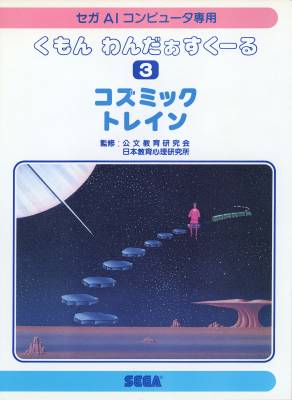 | 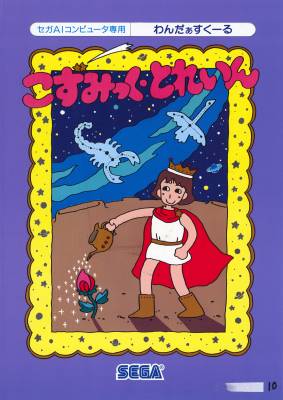 |
| Cosmic Train: 1987 tape version | Cosmic Train: 1988 card version |
- Alice World (ありす・わーるど) early tape version, later card version)
- Robinson Land (ろびんそん・らんど) (early tape version, later card version)
- Cosmic Train (こすみっく・とれいん) (early tape version, later card version)
- Cinderella Labyrinth (しんでれら・らびりんす) (early tape version, later card version)
- Gulliver Pocket (がりばー・ぽけっと) early tape version, later card version)
- Mozart Academy (もーつぁると・あかでみー) early tape version, later card version)
- Arabian Night (あらびあん・ないと) early tape version, later card version)
- Andersen Dream (あんでるせん・どりーむ) (early tape version, later card version)
- Ocean Fantasy (おーしゃん・ふぁんたじー) early tape version, later card version)
- Columbus Map (ころんぶす・まっぷ) early tape version, later card version)
 |  |  | |
| Alice World [Card version] | Alice World [Card version] | Alice World [Card version] | |
 |  |  | |
| Cosmic Train [Card version] | Cosmic Train [Card version] | Andersen Dream [Card version] | |
 |  |  | |
| Arabian Night [Card version] | Cinderella Labyrinth [Card version] | Columbus Map [Card version] | |
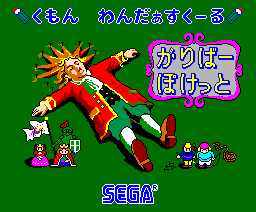 | 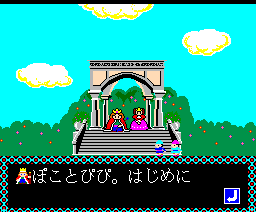 |  | |
| Gulliver Pocket [Card version] | Gulliver Pocket [Card version] | Mozart Academy [Card version] | |
 |  | 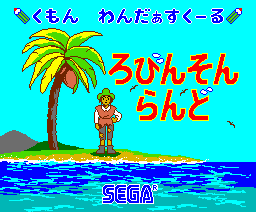 | |
| Ocean Fantasy [Card version] | Ocean Fantasy [Card version] | Robinson Land [Card version]] |
Ongaku Wonder School
- Runrun Music (るんるん・みゅーじっく) (card)
- Tantan Rhythm (たんたん・りずむ) (card)
- Ranran Melody (らんらん・めろでぃー) (card)
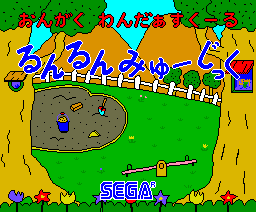 | 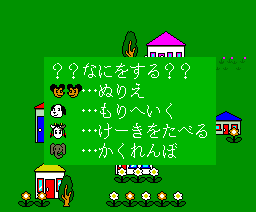 |  |
| Runrun Music | Tantan Rhythm | Ranran Melody |
English Wonder School
- Folks & Fairy Tales - Eigo de Hanashi (Folk & Fairy Tales - えいごでおはなし) (two cards + two tapes)
- Popo Adventure's - Eigo de Game (Popo's Adventure - えいごでげーむ) (two cards + two tapes)
 | 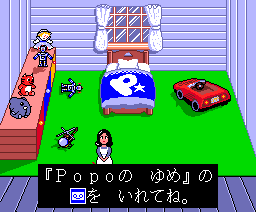 | |
| Popo's Adventure: Popo no Yume | Popo's Adventure: Popo no Yume | |
 |  |  |
| Folk & Fairy Tales | Folk & Fairy Tales | Folk & Fairy Tales |
Surasura Moji Wonder School
- Henshin Kanji (へんしんかんじ) (card)
- Okeiko/Hanamaru Aiueo (おけいこ・はなまる あいえうお) (two cards)
- Waku Waku ABC To 123 (わくわくABCと123) (card)
 |  |  |
| Henshin Kanji | Waku Waku ABC To 123 | Waku Waku ABC To 123 |
Pinpon Pasokon
- Pinpon Numbers (ピンポン ナンバーズ) (card)
- Pinpon Music Rhythm (ピンポン ミュージック リズム) (card)
- Pinpon Music Melody (ピンポン ミュージック メロディー) (card)
 |  |  |
| Pinpon Pasokon splash screen | Pinpon Music Melody | Pinpon Music Melody |
What we haven't found so far
AI Enikki: Cassette version was spotted in an auction, we couldn’t acquire it.
Edison Labo: mentioned in Kumon Wonder School Japanese flyer, with screenshots.
Mentions of other titles at SukaSega's AI page (exact source unknown)
- Edison’s Labo (エジソンラボ)
- Lincoln Freedom (リンカーン・フリーダム)
- Grimm House (グリム・ハウス)
- Holmes Mystery (ホームズ・ミステリー)
- Anne Diary (アンネ・ダイアリー)
- Columbus Egg (コロンブス・エッグ) → Likely same as “Columbus Map”
- Takara Jima Pirates (宝島・パイレーツ)
- Space Fantasy (スペース・ファンタジー)
- Safari Fantasy (サファリ・ファンタジー)
- Mothers Book (マザーズブック)
COPEL 21 December 1986 and January 1987 issues contains an ad showing 18 boxes (likely mockups) with readable names:
- Alice World (アリス ワールド)→ Released
- Robinson World (ロビンソン ワールド)→ Released as “Robinson Land”
- Cinderella World (シンデレラ ワールド)→ Released as “Cinderella Labyrinth”
- Aesop World (イソップ ワールド)
- Hansel & Gretel (へんセル&グレーテル ワールド)
- Goku World (ゴクウ ワールド)
- Taka Jima World (高島 ワールド)
- Helen Keller World (ヘレン ケラー ワールド)
- Nightingale World(ナイチンゲール ワールド)
- Jeanne d’Arc World (ジャンヌ・ダルク ワールド)
- Edison World (エジソン ワールド)→ Later referred to as “Edison’s Labo”
- Lincoln World (リンカーン ワールド)→ Later referred to as “Lincoln Freedom”
- Space World (スペース(宇宙)ワールド)
- Safari World (サファリ(??)ワールド)
- Robot World (ロボット ワールド)
- Mother World 1 (マザー ワールド1)
- Mother World 2 (マザー ワールド2)
- Mother World 3 (マザー ワールド3)
It is unlikely that those titles were all finished or released, but we have screenshots for “Edison’s Labo” in a flyer so this one was likely developed.
Downloads
System Roms
The system dumps amount to a total of 590 KB of uncompressed data.
- Sega AI Computer - System Roms.zip (382 KB)
- AI-E000.bin: system EPROM 0, marked 8/24 (64 kb)
- AI-F000.bin: system EPROM 1, marked 7/21 (64 kb), contains string:
7/19/86 - AI-MPR-7619.bin: speech ROM 0 (128 kb)
- AI-MPR-7620.bin: speech ROM 1 (128 kb)
- AI-MPR-7689.bin: character ROM (128 kb)
- AI-SND-AI2002.bin: sound box EPROM (128 kb), contains strings:
Programed by SHUN ARAI.Produced by YASUHIGE KOBAYASHI.Special Thanks KAMIYA STUDIO & PHILOS [...] R&D No.6SOUND BOARD V1.187/08/12 SEGA
Software Roms & Overlay
The 26 Sega My Card dumps amount to a total of 4.2 MB of uncompressed data. We also scan all overlays at had at our disposal.
- Sega AI Computer - 26 Cards Roms.zip (1941 kB)
- Sega AI Computer - 26 Overlay Scans.zip (10 MB)
MAME ready Roms folder
As MAME use specific naming convention for its files, we provide a readily usable folder:
Tapes recordings
Important: Very large data. The 14 cassettes (16 sides in total) currently amount to about ~1.2 GB of data. Please don't download unless you have use for this: the cassette system is NOT emulated a the time of writing, thus the data from our cassette dumps was not yet certified as “correct” (as in, passing the Sega AI Computer loading routines and probable checksum checks). According to early research, tapes are using a FSK modulation scheme, with a theoretical maximum bit-rate of 9600 BPS which is very high for its time. Actual bit-rate used seems at least two times lower. We are currently releasing 48 Khz, 24-bit stereo lossless FLAC. It is probable that once emulated, we can settle on a compact format for the data segments, or can tell what level of audio compression is adequate for loading in a real system and emulators.
Tape downloads are available from our Our Big Shared Folder.
- Alice World [Tape version] (Tape).flac (~5 minutes)
- Andersen Dream [Tape version] (Tape).flac (~9 minutes)
- Arabian Night [Tape version] (Tape).flac (~10 minutes)
- Cinderella Labyrinth [Tape version] (Tape).flac (~5 minutes)
- Columbus Map [Tape version] (Tape).flac (~5 minutes)
- Cosmic Train [Tape version] (Tape).flac (~9 minutes)
- Folk and Fairy Tales - Eigo de Ohanashi 1 (Tape Side A).flac (~15 minutes)
- Folk and Fairy Tales - Eigo de Ohanashi 1 (Tape Side B).flac (~15 minutes)
- Folk and Fairy Tales - Eigo de Ohanashi 2 (Tape Side A).flac (~16 minutes)
- Folk and Fairy Tales - Eigo de Ohanashi 2 (Tape Side B).flac (~16 minutes)
- Gulliver Pocket [Tape version] (Tape).flac (~5 minutes)
- Mozart Academy [Tape version] (Tape).flac (~5 minutes)
- Ocean Fantasy [Tape version] (Tape).flac (~11 minutes)
- Popo's Adventure - Eigo de Game 1 - Popo no Yume (Tape).flac (~16 minutes)
- Popo's Adventure - Eigo de Game 2 - Popoland no Himitsu (Tape).flac (~18 minutes)
- Robinson Land [Tape version] (Tape).flac (~5 minutes)
Hardware Manuals
- Sega AI Computer - Main Unit Manual.pdf (15 MB)
- Sega AI Computer - Sound Box Manual.pdf (9 MB)
- Sega AI Computer - Keyboard Manual.pdf (15 MB)
 |  |
Software Scans
Flyers & Ads
- Flyer - CAI-1 (1986-04) (Japan).pdf (26 MB) (courtesy of Sudden-Desu)
- Flyer - Sega AI Computer (Japan).pdf (20 MB) (courtesy of Sudden-Desu)
- see our Big Shared Folder for many more.
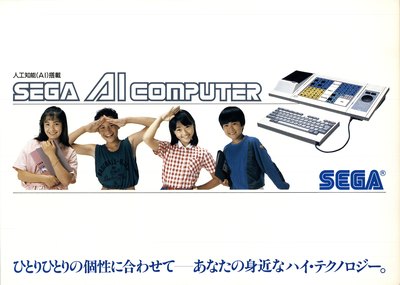 |  |
 |  |
Photos
See our Big Shared Folder for:
- about 150 photos from all past known auctions/sales of Sega AI Computer contents.
- close up photos of Sega AI Main Unit
- close up photos of Sega AI Main Unit board
- close up photos of Sega AI Keyboard
- close up photos of Sega AI Sound Box board
- photos of software packaging
- archived webpages about an unreleased US prototype
- and more...
 |  |
 |  |
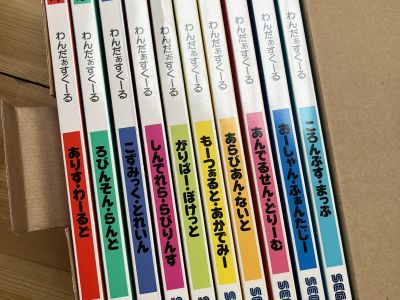 |  |
 | 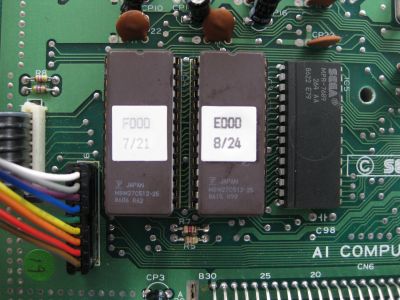 |
Magazine Scans
- COPEL 21 - 1986-12 - Article and Ad (Japan).pdf (30 MB)
- see our Big Shared Folder for many more.
Technical documentations
- Sega AI Computer - Misc Technical Docs (2024-01-29).zip (122 KB) various notes and schematics by Chris Covell.
- Also see Reverse engineering thread.
Links
Our big shared folder
- Our Big Shared Folder has about 700 files, 1.6 GB of data.
External resources
- http://park21.wakwak.com/~suka/sega/catalog/AIcom/AI.html
- https://segaretro.org/Sega_AI_Computer
- https://archive.org/search?query=%22%E3%82%BB%E3%82%ACAI%22&sin=TXT
Site sections
- https://www.smspower.org/Games-Releases/AI-JP
- https://www.smspower.org/Games/AI-All
- https://www.smspower.org/Scans/AI-All
Forum threads
- https://www.smspower.org/forums/15004-SegaAIComputerSoftware
- https://www.smspower.org/forums/15244-SegaAIComputerReverseEngineeringThread
- https://www.smspower.org/forums/19976-SegaAIComputerFirstDumpsSystemRomsScansRecordingsMore
Research credits
Credits
- Chris Covell (https://www.chrismcovell.com) did the majority of the early hardware reverse engineering, documentation and software dumping.
- Wilbert Pol and Fabio Priuli went on to create a MAME driver. Early work was actually done in 2015. As we uncovered new software and received it in late 2023, we decided to resume work on this release and Wilbert took care of further emulation work. A first version of the driver was merged into MAME’s codebase on January 23, 2024 (pull request).
- Omar Cornut acquired hardware and software, dumped software cards and tapes acquired later, scanned contents, researched information and organized other work.
- Charles MacDonald helped build a custom My Card adapter with configurable pinouts to facilitate dumping later finds.
- Game Preservation Society received the hardware and made the first pass on trying to dump the data. It was found that the Sega AI cards share the pinouts of Sega MyCards used for the SG-1000 II and Master System. A first set of (incomplete) dumps were made which would help moving emulation forward until the unit and software were passed to Chris.
 |  |
| Chris dumping speech roms | Charles adapter |
Special Thanks
- Thanks to Odin Ozdil for helping acquire extra software and scanning the Sega AI Computer manual.
- Thanks to Masato Ozaki, BEEP Shop & Takayuki Komabayashi for helping me acquire extra software.
- Thanks to Gorefestor board photos and for help writing this article.
- Thanks to Black Squirrel for help writing this article.
- Thanks to KailoKyra for scan processing, assistance with tape dumping & more.
- Thanks to Balrog for assistance with tape dumping.
- Thanks to SukaSega for many early scans and research.
- Thanks to BKK for general research.
- Thanks to Sudden-desu for high-resolution scans of two Japanese flyers.
- Thanks to Maxim for general support, corrections, web work & many more.
- Thanks to generous donors helping buying the first batch: initial purchase received funds from: Adrien Duchemole, Bock, Chris Covell, David Papazian (Mobigame), Frank Cifaldi (Video Game History Foundation), Kusfo, Game Preservation Society, GlobZ, Gregg "Greggman" Tavares, Olivier L, Vitorio Miliano.
About SMS Power!
- Active since 1997, SMS Power! has been researching, gathering and publishing all sort of information and data related to Sega 8-bit systems. We unveiled hundreds of prototypes, and have an active community of hobbyists contributors creating maps, soundtracks, game modifications, translations and more. You may if you can Donate to facilitate purchasing prototypes and rare software.

